control VOLVO XC90 TWIN ENGINE 2020 Owners Manual
[x] Cancel search | Manufacturer: VOLVO, Model Year: 2020, Model line: XC90 TWIN ENGINE, Model: VOLVO XC90 TWIN ENGINE 2020Pages: 693, PDF Size: 13.34 MB
Page 5 of 693
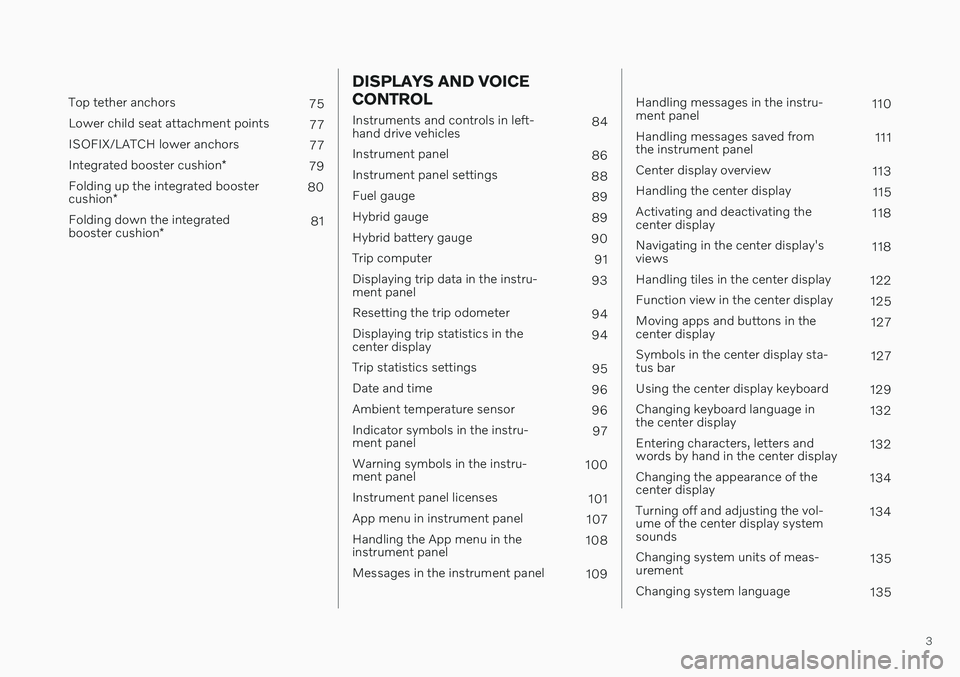
3
Top tether anchors75
Lower child seat attachment points 77
ISOFIX/LATCH lower anchors 77
Integrated booster cushion *
79
Folding up the integrated booster cushion * 80
Folding down the integratedbooster cushion * 81
DISPLAYS AND VOICE CONTROL
Instruments and controls in left- hand drive vehicles
84
Instrument panel 86
Instrument panel settings 88
Fuel gauge 89
Hybrid gauge 89
Hybrid battery gauge 90
Trip computer 91
Displaying trip data in the instru-ment panel 93
Resetting the trip odometer 94
Displaying trip statistics in thecenter display 94
Trip statistics settings 95
Date and time 96
Ambient temperature sensor 96
Indicator symbols in the instru-ment panel 97
Warning symbols in the instru-ment panel 100
Instrument panel licenses 101
App menu in instrument panel 107
Handling the App menu in theinstrument panel 108
Messages in the instrument panel 109
Handling messages in the instru- ment panel 110
Handling messages saved fromthe instrument panel 111
Center display overview 113
Handling the center display 115
Activating and deactivating thecenter display 118
Navigating in the center display'sviews 118
Handling tiles in the center display 122
Function view in the center display 125
Moving apps and buttons in thecenter display 127
Symbols in the center display sta-tus bar 127
Using the center display keyboard 129
Changing keyboard language inthe center display 132
Entering characters, letters andwords by hand in the center display 132
Changing the appearance of thecenter display 134
Turning off and adjusting the vol-ume of the center display systemsounds 134
Changing system units of meas-urement 135
Changing system language 135
Page 6 of 693
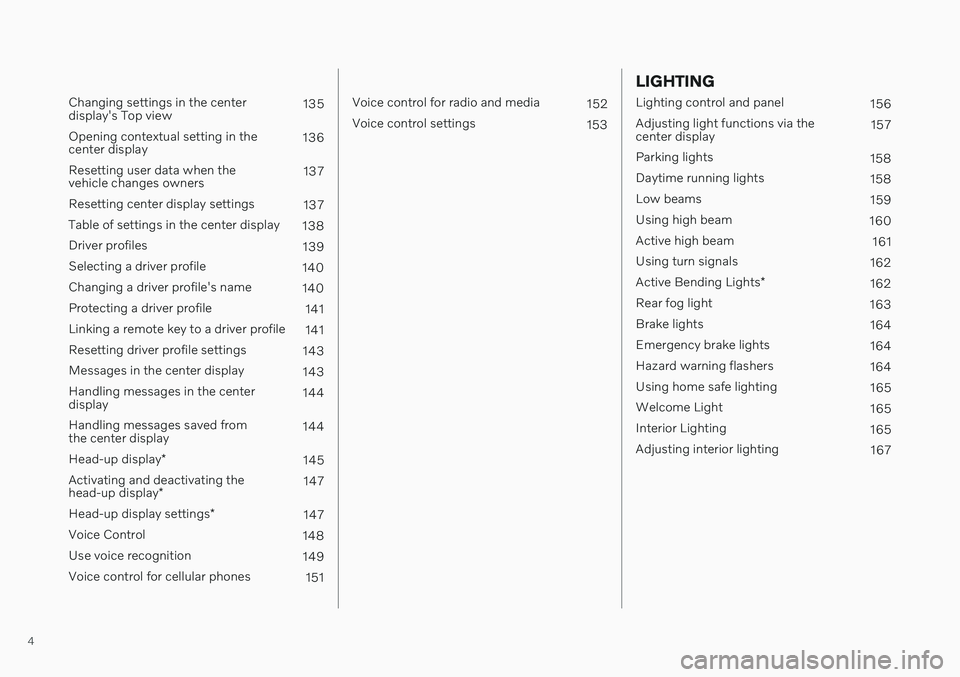
4
Changing settings in the center display's Top view135
Opening contextual setting in thecenter display 136
Resetting user data when thevehicle changes owners 137
Resetting center display settings 137
Table of settings in the center display 138
Driver profiles 139
Selecting a driver profile 140
Changing a driver profile's name 140
Protecting a driver profile 141
Linking a remote key to a driver profile 141
Resetting driver profile settings 143
Messages in the center display 143
Handling messages in the centerdisplay 144
Handling messages saved fromthe center display 144
Head-up display *
145
Activating and deactivating the head-up display * 147
Head-up display settings *
147
Voice Control 148
Use voice recognition 149
Voice control for cellular phones 151
Voice control for radio and media152
Voice control settings 153
LIGHTING
Lighting control and panel 156
Adjusting light functions via the center display 157
Parking lights 158
Daytime running lights 158
Low beams 159
Using high beam 160
Active high beam 161
Using turn signals 162
Active Bending Lights *
162
Rear fog light 163
Brake lights 164
Emergency brake lights 164
Hazard warning flashers 164
Using home safe lighting 165
Welcome Light 165
Interior Lighting 165
Adjusting interior lighting 167
Page 7 of 693
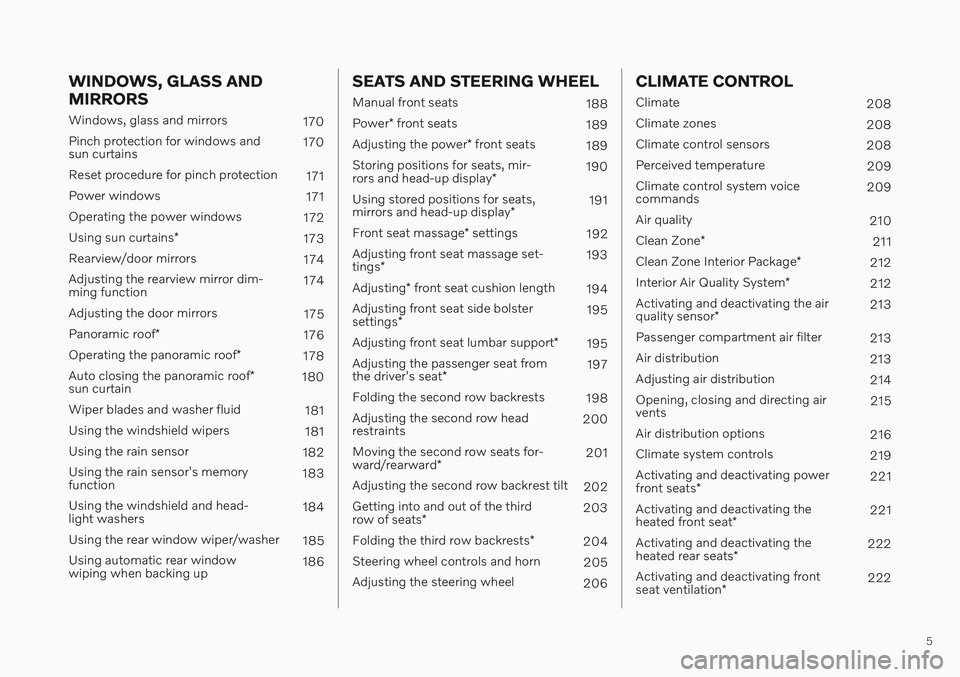
5
WINDOWS, GLASS AND MIRRORS
Windows, glass and mirrors170
Pinch protection for windows and sun curtains 170
Reset procedure for pinch protection 171
Power windows 171
Operating the power windows 172
Using sun curtains *
173
Rearview/door mirrors 174
Adjusting the rearview mirror dim-ming function 174
Adjusting the door mirrors 175
Panoramic roof *
176
Operating the panoramic roof *
178
Auto closing the panoramic roof *
sun curtain 180
Wiper blades and washer fluid 181
Using the windshield wipers 181
Using the rain sensor 182
Using the rain sensor's memoryfunction 183
Using the windshield and head-light washers 184
Using the rear window wiper/washer 185
Using automatic rear windowwiping when backing up 186
SEATS AND STEERING WHEEL
Manual front seats
188
Power * front seats
189
Adjusting the power * front seats
189
Storing positions for seats, mir- rors and head-up display *190
Using stored positions for seats,mirrors and head-up display *191
Front seat massage * settings
192
Adjusting front seat massage set-tings * 193
Adjusting * front seat cushion length
194
Adjusting front seat side bolstersettings * 195
Adjusting front seat lumbar support *
195
Adjusting the passenger seat fromthe driver's seat * 197
Folding the second row backrests 198
Adjusting the second row head restraints 200
Moving the second row seats for- ward/rearward * 201
Adjusting the second row backrest tilt 202
Getting into and out of the thirdrow of seats * 203
Folding the third row backrests *
204
Steering wheel controls and horn 205
Adjusting the steering wheel 206
CLIMATE CONTROL
Climate208
Climate zones 208
Climate control sensors 208
Perceived temperature 209
Climate control system voice commands 209
Air quality 210
Clean Zone *
211
Clean Zone Interior Package *
212
Interior Air Quality System *
212
Activating and deactivating the air quality sensor * 213
Passenger compartment air filter 213
Air distribution 213
Adjusting air distribution 214
Opening, closing and directing air vents 215
Air distribution options 216
Climate system controls 219
Activating and deactivating power front seats * 221
Activating and deactivating theheated front seat * 221
Activating and deactivating theheated rear seats * 222
Activating and deactivating frontseat ventilation * 222
Page 8 of 693
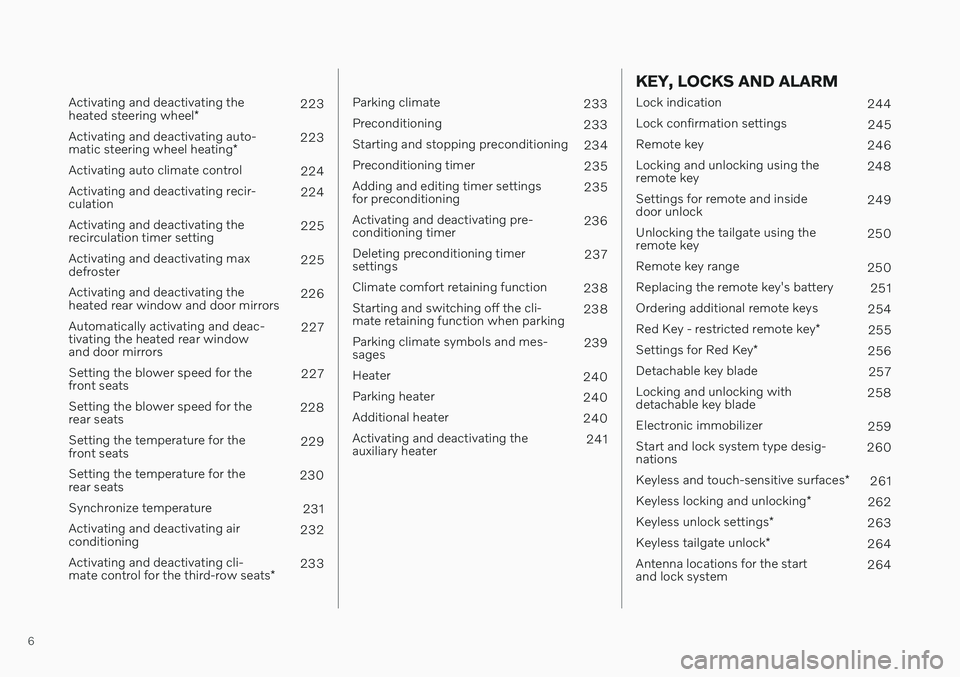
6
Activating and deactivating the heated steering wheel*223
Activating and deactivating auto-matic steering wheel heating *223
Activating auto climate control 224
Activating and deactivating recir- culation 224
Activating and deactivating therecirculation timer setting 225
Activating and deactivating maxdefroster 225
Activating and deactivating theheated rear window and door mirrors 226
Automatically activating and deac-tivating the heated rear windowand door mirrors 227
Setting the blower speed for thefront seats 227
Setting the blower speed for therear seats 228
Setting the temperature for thefront seats 229
Setting the temperature for therear seats 230
Synchronize temperature 231
Activating and deactivating airconditioning 232
Activating and deactivating cli- mate control for the third-row seats *233
Parking climate
233
Preconditioning 233
Starting and stopping preconditioning 234
Preconditioning timer 235
Adding and editing timer settings for preconditioning 235
Activating and deactivating pre-conditioning timer 236
Deleting preconditioning timersettings 237
Climate comfort retaining function 238
Starting and switching off the cli-mate retaining function when parking 238
Parking climate symbols and mes-sages 239
Heater 240
Parking heater 240
Additional heater 240
Activating and deactivating theauxiliary heater 241
KEY, LOCKS AND ALARM
Lock indication
244
Lock confirmation settings 245
Remote key 246
Locking and unlocking using the remote key 248
Settings for remote and insidedoor unlock 249
Unlocking the tailgate using theremote key 250
Remote key range 250
Replacing the remote key's battery 251
Ordering additional remote keys 254
Red Key - restricted remote key *
255
Settings for Red Key *
256
Detachable key blade 257
Locking and unlocking withdetachable key blade 258
Electronic immobilizer 259
Start and lock system type desig-nations 260
Keyless and touch-sensitive surfaces *
261
Keyless locking and unlocking *
262
Keyless unlock settings *
263
Keyless tailgate unlock *
264
Antenna locations for the startand lock system 264
Page 9 of 693
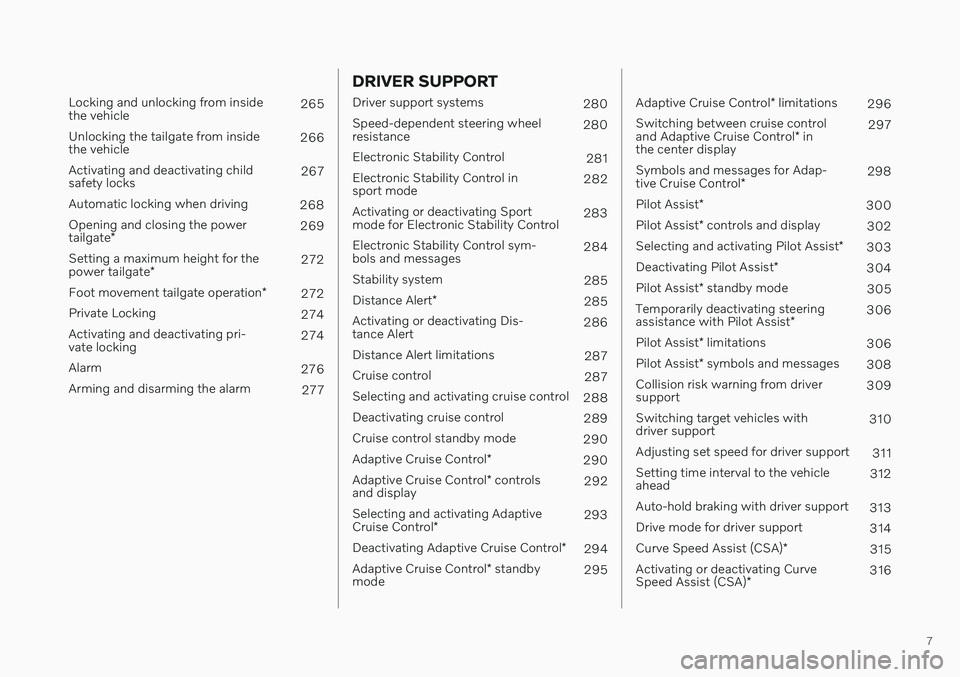
7
Locking and unlocking from inside the vehicle265
Unlocking the tailgate from insidethe vehicle 266
Activating and deactivating childsafety locks 267
Automatic locking when driving 268
Opening and closing the power tailgate * 269
Setting a maximum height for thepower tailgate * 272
Foot movement tailgate operation *
272
Private Locking 274
Activating and deactivating pri- vate locking 274
Alarm 276
Arming and disarming the alarm 277
DRIVER SUPPORT
Driver support systems280
Speed-dependent steering wheel resistance 280
Electronic Stability Control 281
Electronic Stability Control insport mode 282
Activating or deactivating Sportmode for Electronic Stability Control 283
Electronic Stability Control sym-bols and messages 284
Stability system 285
Distance Alert *
285
Activating or deactivating Dis-tance Alert 286
Distance Alert limitations 287
Cruise control 287
Selecting and activating cruise control 288
Deactivating cruise control 289
Cruise control standby mode 290
Adaptive Cruise Control *
290
Adaptive Cruise Control * controls
and display 292
Selecting and activating Adaptive Cruise Control * 293
Deactivating Adaptive Cruise Control *
294
Adaptive Cruise Control * standby
mode 295
Adaptive Cruise Control
* limitations
296
Switching between cruise control and Adaptive Cruise Control * in
the center display 297
Symbols and messages for Adap-tive Cruise Control * 298
Pilot Assist *
300
Pilot Assist * controls and display
302
Selecting and activating Pilot Assist *
303
Deactivating Pilot Assist *
304
Pilot Assist * standby mode
305
Temporarily deactivating steeringassistance with Pilot Assist *306
Pilot Assist * limitations
306
Pilot Assist * symbols and messages
308
Collision risk warning from driver support 309
Switching target vehicles withdriver support 310
Adjusting set speed for driver support 311
Setting time interval to the vehicleahead 312
Auto-hold braking with driver support 313
Drive mode for driver support 314
Curve Speed Assist (CSA) *
315
Activating or deactivating Curve Speed Assist (CSA) * 316
Page 10 of 693

8
Curve Speed Assist (CSA)* limitations
316
Passing assistance 317
Using passing assistance 317
Radar sensor 318
Radar sensor type approval 319
Camera 321
Camera/radar sensor limitations 322
Recommended camera and radar sensor maintenance 326
City Safety ™
327
City Safety sub-functions 328
Setting a warning distance forCity Safety 330
Detecting obstacles with City Safety 331
City Safety in crossing traffic 333
Limitations of City Safety in cross-ing traffic 334
City Safety steering assistance forevasive maneuver 335
Automatic braking during delayedevasive maneuvers with City Safety 335
City Safety braking for oncomingvehicles 336
City Safety limitations 337
City Safety messages 340
Rear Collision Warning *
341
Rear Collision Warning * limitations
341
BLIS *
342
Activating or deactivating BLIS 343
BLIS limitations 344
BLIS messages 345
Cross Traffic Alert *
346
Activating or deactivating Cross Traffic Alert * 347
Cross Traffic Alert * limitations
347
Cross Traffic Alert * messages
349
Road Sign Information *
350
Activating or deactivating RoadSign Information * 351
Road Sign Information * display
351
Road Sign Information andSensus Navigation * 352
Speed limit and speed camerawarnings from Road Sign Information *352
Activating or deactivating warn-ings from Road Sign Information *353
Road Sign Information * limitations
354
Driver Alert Control 355
Activating or deactivating Driver Alert Control 356
Selecting guidance to a rest area ifthe Driver Alert Control warninghas been given 356
Driver Alert Control limitations
357
Lane Keeping Aid 357
Activating or deactivating Lane Keeping Aid 359
Selecting type of assistance forLane Keeping Aid 359
Lane Keeping Aid limitations 360
Lane Keeping Aid symbols andmessages 361
Lane Keeping Aid display 363
Steering assistance at risk of collision 364
Activating or deactivating steeringassistance during collision risks 365
Run-Off Mitigation with steeringassistance 365
Steering assistance during colli-sion risks from oncoming traffic 366
Steering assistance during colli- sion risks from behind *367
Steering assistance during colli- sion risks limitations 368
Symbols and messages for steer-ing assistance during collision risks 369
Park Assist *
370
Park Assist front, rear and sides *
371
Activating or deactivating Park Assist *
372
Park Assist limitations 372
Park Assist symbols and messages 374
Page 12 of 693
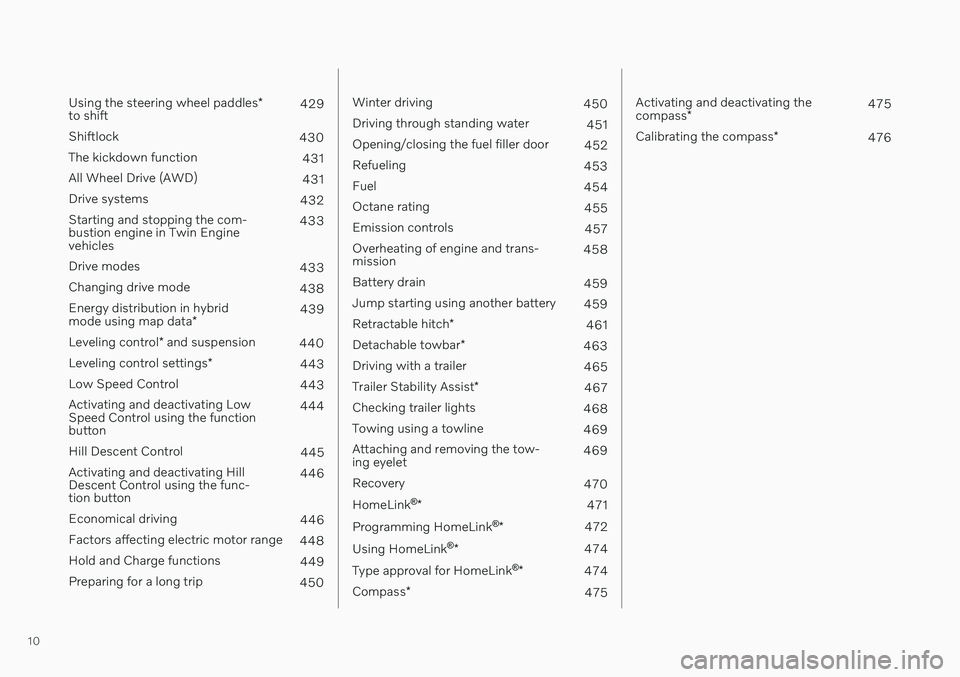
10
Using the steering wheel paddles*
to shift 429
Shiftlock 430
The kickdown function 431
All Wheel Drive (AWD) 431
Drive systems 432
Starting and stopping the com- bustion engine in Twin Enginevehicles 433
Drive modes 433
Changing drive mode 438
Energy distribution in hybrid mode using map data *439
Leveling control * and suspension
440
Leveling control settings *
443
Low Speed Control 443
Activating and deactivating Low Speed Control using the functionbutton 444
Hill Descent Control 445
Activating and deactivating HillDescent Control using the func-tion button 446
Economical driving 446
Factors affecting electric motor range 448
Hold and Charge functions 449
Preparing for a long trip 450
Winter driving450
Driving through standing water 451
Opening/closing the fuel filler door 452
Refueling 453
Fuel 454
Octane rating 455
Emission controls 457
Overheating of engine and trans- mission 458
Battery drain 459
Jump starting using another battery 459
Retractable hitch *
461
Detachable towbar *
463
Driving with a trailer 465
Trailer Stability Assist *
467
Checking trailer lights 468
Towing using a towline 469
Attaching and removing the tow-ing eyelet 469
Recovery 470
HomeLink ®
* 471
Programming HomeLink ®
* 472
Using HomeLink ®
* 474
Type approval for HomeLink ®
* 474
Compass *
475
Activating and deactivating the compass* 475
Calibrating the compass *
476
Page 13 of 693

11
AUDIO, MEDIA AND INTERNET
Audio, media and Internet478
Sound settings 478
Sound experience *
479
Apps 480
Download apps 481
Updating apps 481
Deleting apps 482
Radio 482
Starting the radio 483
Changing waveband and radio station 484
Searching for a radio station 484
Storing radio channels in the Radio favorites app 485
Radio settings 486
RBDS 486
HD Radio ™
487
Activating and deactivating the HDRadio ™ 488
HD Radio ™ sub-channels
488
HD Radio ™ limitations
489
SiriusXM ®
Satellite radio *
490
Using SiriusXM ®
Satellite radio *
491
Settings for SiriusXM ®
Satellite radio *
492
SiriusXM Travel Link ®
* 494
SiriusXM Travel Link ®
* - Weather
495
SiriusXM Travel Link ®
* - Notifications
496
SiriusXM Travel Link ®
* - Fuel
497
SiriusXM Travel Link ®
* - Sports
498
Media player 499
Playing media 500
Controlling and changing media 501
Media searches 502
Gracenote ®
503
CD player *
503
Video 504
Playing video 504
Playing DivX ®
504
Video settings 505
Streaming media via Bluetooth ®
505
Connecting a device via Bluetooth ®
505
Playing media via the USB port 506
Connecting a device via the USB port 506
Technical specifications for USB devices 507
Compatible file formats for media 507
Apple ®
CarPlay ®
* 508
Using Apple ®
CarPlay ®
* 509
Settings for Apple ®
CarPlay ®
* 511
Tips for using Apple ®
CarPlay ®
* 511
Android Auto *
512
Using Android Auto *
513
Settings for Android Auto *
514
Tips for using Android Auto *
514
Phone 515
Connecting a phone to the car via Bluetooth for the first time 516
Connecting a phone to the car viaBluetooth automatically 518
Connecting a phone to the car viaBluetooth manually 518
Disconnecting a Bluetooth-con-nected phone 518
Switch between phones connectedvia Bluetooth 519
Disconnecting Bluetooth-con-nected devices 519
Handling phone calls 519
Handling text messages 520
Text message settings 521
Managing the phone book 522
Phone settings 522
Settings for Bluetooth devices 523
Internet-connected vehicle *
524
Connecting the vehicle to the Inter-net via a Bluetooth-connected phone 525
Page 15 of 693
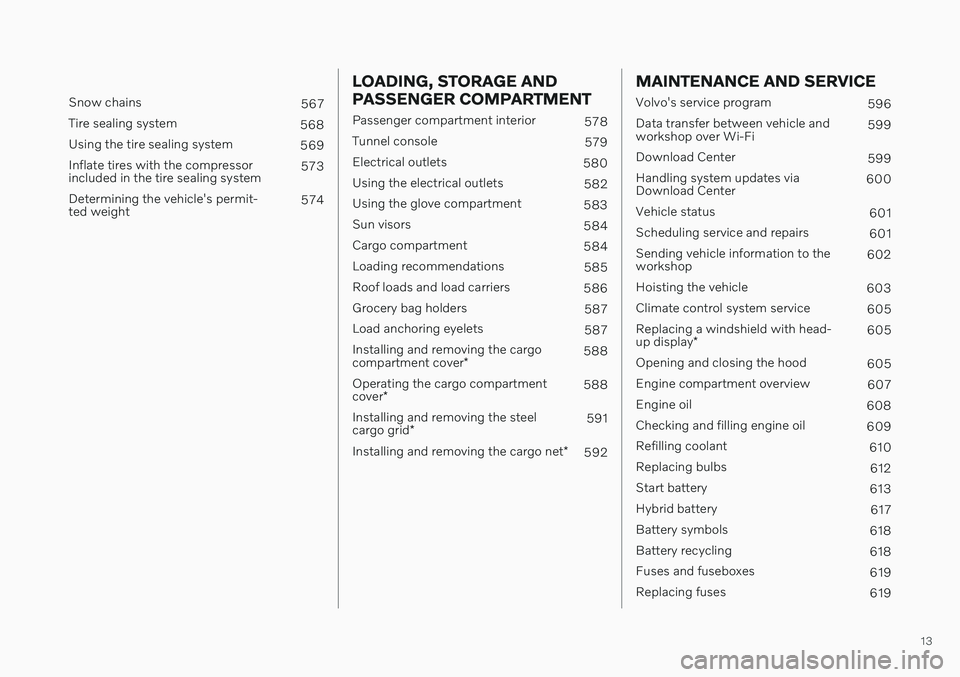
13
Snow chains567
Tire sealing system 568
Using the tire sealing system 569
Inflate tires with the compressor included in the tire sealing system 573
Determining the vehicle's permit-ted weight 574
LOADING, STORAGE AND PASSENGER COMPARTMENT
Passenger compartment interior
578
Tunnel console 579
Electrical outlets 580
Using the electrical outlets 582
Using the glove compartment 583
Sun visors 584
Cargo compartment 584
Loading recommendations 585
Roof loads and load carriers 586
Grocery bag holders 587
Load anchoring eyelets 587
Installing and removing the cargo compartment cover * 588
Operating the cargo compartmentcover * 588
Installing and removing the steelcargo grid * 591
Installing and removing the cargo net *
592
MAINTENANCE AND SERVICE
Volvo's service program
596
Data transfer between vehicle and workshop over Wi-Fi 599
Download Center 599
Handling system updates viaDownload Center 600
Vehicle status 601
Scheduling service and repairs 601
Sending vehicle information to theworkshop 602
Hoisting the vehicle 603
Climate control system service 605
Replacing a windshield with head- up display * 605
Opening and closing the hood 605
Engine compartment overview 607
Engine oil 608
Checking and filling engine oil 609
Refilling coolant 610
Replacing bulbs 612
Start battery 613
Hybrid battery 617
Battery symbols 618
Battery recycling 618
Fuses and fuseboxes 619
Replacing fuses 619
Page 32 of 693

YOUR VOLVO
30
Drive-E ‒ purer driving pleasure
Volvo is committed to the well-being of its customers. As a natural part of this commit-ment, we care about the environment inwhich we all live. Concern for the environ-ment means an everyday involvement inreducing our environmental impact.
Volvo's environmental activities are based on a holistic view, which means we consider theoverall environmental impact of a productthroughout its complete life cycle. In this con-text, design, production, product use, andrecycling are all important considerations. Inproduction, Volvo has partly or completelyphased out several chemicals including CFCs,lead chromates, asbestos, and cadmium; andreduced the number of chemicals used in ourplants 50% since 1991. Volvo was the first in the world to introduce into production a three-way catalytic converterwith a Lambda sond, now called the heatedoxygen sensor, in 1976. The current version ofthis highly efficient system reduces emissionsof harmful substances (CO, HC, NOx) from theexhaust pipe by approximately 95 - 99% andthe search to eliminate the remaining emis-sions continues. Volvo is the only automobilemanufacturer to offer CFC-free retrofit kits forthe air conditioning system of all models as farback as the 1975 model 240. Advanced elec-tronic engine controls and cleaner fuels arebringing us closer to our goal. In addition to continuous environmental refinement of con-ventional gasoline-powered internal combus-tion engines, Volvo is actively looking atadvanced technology alternative-fuel vehicles. When you drive a Volvo, you become our part- ner in the work to lessen the vehicle's impacton the environment. To reduce your vehicle'senvironmental impact, you can:
Maintain proper air pressure in your tires.Tests have shown decreased fuel econ-omy with improperly inflated tires.
Follow the recommended maintenanceschedule in your Warranty and ServiceRecords Information booklet.
Drive at a constant speed whenever possi-ble.
See a trained and qualified Volvo servicetechnician as soon as possible for inspec-tion if the check engine (malfunction indi-cator) light illuminates, or stays on afterthe vehicle has started.
Properly dispose of any vehicle-relatedwaste such as used motor oil, used batter-ies, brake pads, etc.
When cleaning your vehicle, please usegenuine Volvo car care products. All Volvocar care products are formulated to beenvironmentally friendly.
Twin Engine vehicles
If possible, precondition the vehicle withthe charging cable before driving.
If preconditioning is not possible in coldweather, use the seat and steering wheelheating primarily. Avoid heating the entirepassenger compartment, which reducesthe hybrid battery's charge level.
Choose the
Pure drive mode to help mini-
mize electric power consumption.
In hilly terrain, put the gear selector in mode
B to utilize the electric motor's
braking function when the acceleratorpedal is released. This helps charge thehybrid battery.
Related information
Economical driving (p. 446)
Starting and stopping preconditioning(p. 234)
The Owner's Manual and the environment(p. 25)
Air quality (p. 210)